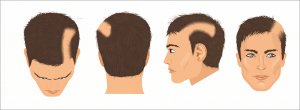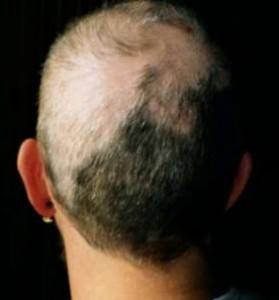Trichotillomania

While trichotillomania is a hair loss condition, it is also diagnosed as a psychological condition since it causes individuals to pull their hair involuntarily. The repeated hair pulling action leads to hair loss in the areas that are manipulated on a regular basis by the patient.
A person can be diagnosed with trichotillomania if:
- The repeated pulling out of the hair results in noticeable hair loss
- There is an increasing sense of tension immediately before pulling out the hair or when attempting to resist the behavior
- Pleasure, satisfaction, or relief is a direct result of pulling out the hair
- The condition is not caused by another mental or medical condition
- The condition causes significant distress or interference in the life of the person (1)
The main cause of this psychological disorder is thought to be anxiety but there are other theories that the condition is the result of genetics, OCD or stress. The diagnosis of trichotillomania is made based on a history of hair pulling, observation of the patients’ behavior and microscopic evidence of broken hair at the affected area.
 Treatment Options
Treatment Options
Modern medicine has not discovered one particular treatment that can be described as “the best option” for everyone suffering from the disease. The two treatment options widely recommended by doctors are:
- Cognitive-Behavior Therapy (CBT) – A therapy option that seeks to alter the behavior of the person by identifying and focusing on the triggers for hair pulling in the patient. The attending doctor seeks to redirect and form positive responses to the triggers.
- Medications – As of the writing of this article, there has not been one particular medicine discovered to work for all trichotillomania patients. Consult with your physician to see if any medications are appropriate for the treatment of your specific symptoms.
Can Hair Transplant Help?
A hair transplant is not recommended if this psychological condition persists for a patient. Hair will regrow in many cases after the treatment of the underlying causes of the condition and when a patient with trichotillomania stops his/her hair pulling behavior. However, hair regrowth is not always complete in these patients and constant traction on hair follicles may cause permanent hair loss.
We do not recommend a hair transplant for at least 6-12 months after the patient stops the hair pulling behavior in order to make sure the behavior of hair pulling does not start again. We also prefer to wait until after the successful completion of any treatment for the underlying psychological condition.
We will reevaluate the condition 6 months after the discontinuation of hair pulling behavior. If there is no clinical evidence of new balding patches following the waiting period and, if a microscopic scalp analysis shows no new lesions, a hair transplant is then a viable option.
A hair transplant can be considered in stable patients only if the patient is recovered from the active phase and not at risk of pulling the hair anymore.
(1) Robin Zasio, Psy.D., LCSW, The Anxiety Treatment Center of Sacramento